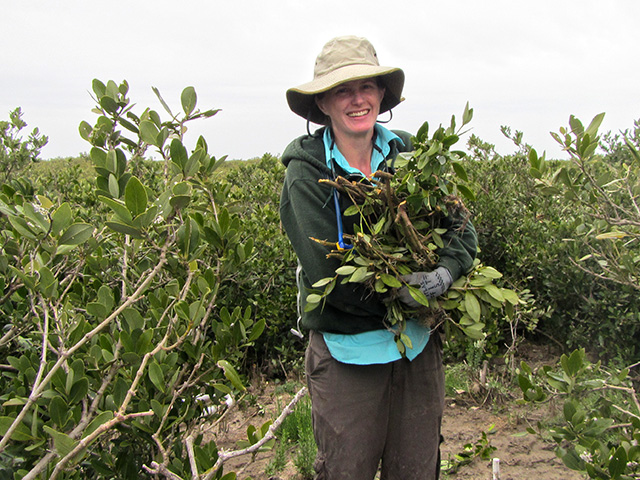World Wetlands Day Q&A with Dr. Anna Armitage
TweetBy Patrick Temperilli, Academic Affairs Marketing and Communications
Dr. Anna Armitage is an associate professor and head of the Coastal and Wetlands Ecology Lab at Texas A&M University at Galveston. Her research focuses on the coastal and wetlands community ecology of salt marshes, tidal mudflats and seagrass beds. In the interview below, she talks about wetlands, her research, and what she's learned in the wake of Hurricane Harvey.

They are called bogs, swamps, marshes, and a host of other unappealing names. So what exactly are wetlands?
Wetlands are vegetated habitats that are transitions between wet and dry areas - areas with plants where the water meets land. Wetlands can occur on the edges of lakes, along rivers, and in estuaries and bays. All those different names you mentioned refer to the type of water (fresh vs salt), the type of vegetation (grasses, trees, and others), and where they are (warm or temperate regions).
Given that there is an international day devoted to wetlands, how important are they?
Wetlands hold many treasures. There are many animals that rely on wetlands for part or all of their life cycle. Commercial and recreational fishing industries and birdwatching ecotourism rely on wetlands as habitat for their species of interest. The plants in wetlands filter the water and remove pollutants, making the water cleaner and safer downstream for humans and wildlife alike. Wetlands protect shorelines and absorb floodwaters, helping to protect nearby neighborhoods.
World Wetlands Day began in 1997. Have you seen a growing appreciation for the role wetlands play in our environment?
Slowly, yes there has been a growing appreciation for the wide range of benefits that wetlands provide to us. However, there is still a long way to go and many opportunities for continued education lie ahead. Laws protecting wetlands in the U.S. have been loosened recently, making education even more paramount.
The theme for this year's World Wetlands Day is Wetlands for a Sustainable Urban Future. In the wake of Hurricane Harvey last semester, how relevant is that?
There is evidence that wetlands can reduce flooding from storm events, both along the coast and in urban areas. This is particularly true for the "typical" rainstorms that occur in the Galveston Bay area most years. Harvey was an unusual event - there was so much rain that most wetlands in the greater Houston area filled up and flooding happened anyway. However, with strategic restoration and creation of wetlands within urban environments, some flooding can still be averted. Exploration Green in Clear Lake is one example of how an urban wetland reduced the severity of impacts from Harvey.
You were awarded an NSF grant for your research. How has the research been going and how connected is it to wetlands?
Mangroves are a type of wetland vegetation – mangroves are salt tolerant trees that live in the intertidal zone. The central goal of our NSF RAPID project is to determine if mangroves provide different – or better – shoreline protection ecosystem services than salt marshes (mostly grasses and forbs) during high-energy storms. So far, we have seen that mangroves did reduce shoreline erosion, but mangroves were also more damaged by the wind surge from the storm. We will continue to track the recovery of the plants to see if marsh or mangrove vegetation is more resilient following major storm events.
What are your hopes for the future of wetlands?
Wetlands provide us with many benefits, from unique wildlife, to cleaner water, to safer urban communities. I hope that appreciation for these gifts continues to grow, as will support for protecting these valuable resources.
You can learn more about Dr. Armitage and her research by visiting the Coastal and Wetlands Ecology Lab. You can also follow her and her researchers on Facebook and Twitter.
###